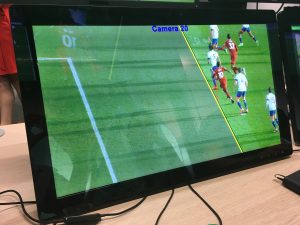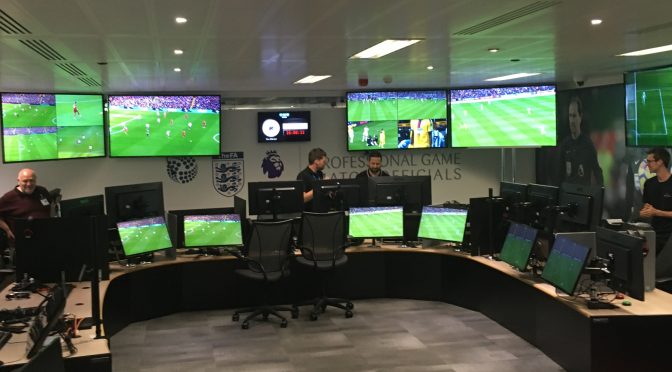Representatives from the Chelsea Supporters Trust attended education sessions regarding VAR at the Stockley Park HQ last week.
Video Assisted Referee (VAR) was voted in unanimously by Premier League clubs to be introduced for the 2019/20 season and until they vote against it, it is here to stay.
VAR philosophy is “minimum interference, maximum benefit,” which, of course remains to be seen!
The system has been tested extensively over nearly three years and the Premier League now believes they are ready to go live. The system has been shown and explained to football club staff, players, journalists, media pundits, commentators and supporters representatives.
The words “open” and “transparent” were used a lot during the session.
Who is the referee? What happens when there are lots of games going on at once?
Every match has its own dedicated team featuring a VAR , an Assistant VAR and a Technical Expert. Therefore if 10 games are played simultaneously such as happens on the last day of the season, there will be 10 VAR teams each monitoring their game.
The assistant keeps watching the game in play while the VAR is reviewing a decision. The VAR is a fully qualified Premier League  referee; next season when the match day referees are announced for the coming round of PL games, they will announce the VAR for each game at the same time.
referee; next season when the match day referees are announced for the coming round of PL games, they will announce the VAR for each game at the same time.
If the system breaks down (for example there is a communications failure somewhere breaking the link between the VAR Control Centre and the ground), there should be an announcement inside the ground letting everyone know that VAR is not in operation, and another when it is back on again. This is apparently the protocol for the goal line technology we already have in place.
What does use of VAR cover?
The VAR system covers ‘clear and obvious errors’ and ‘serious missed incidents’ in relation to goals, penalties, (straight) red-cards and cases of mistaken identity. The Premier League are pushing the message “minimal interference maximum benefit”
‘Clear and obvious errors’ is probably the most misunderstood or misinterpreted part of this; one of the most contentious uses of VAR is for marginal offsides, how can being an inch on or offside be considered a clear and obvious error? It was made very plain in the presentation that, because they can measure to a high level of accuracy, it is considered a matter of fact and will always be checked – like the goal line technology we have got used to in recent years. You may not agree but that is the way it is treated by the authorities.
When it comes to determining whether a player should receive a red card for a dangerous tackle however, the ‘clear and obvious error’ test does apply. During the briefing we looked at a tackle from a game last season when a late tackle from a defender was given a yellow card, the referee judging it to be reckless but not dangerous; whilst we almost all felt that it was a dangerous tackle worthy of a red, it was also agreed that this was not sufficiently clear cut to overrule the referee’s decision. However another example was shown where it was right to intervene and a red card was issued after VAR intervention – a blatant sending off.
VAR can also be used if it there is a potential case of mistaken identity when a player has been given a yellow or red card.
Doesn’t slow motion make everything look deliberate?
When reviewing incidents of handball or foul play, the review is first conducted in real time to get the sense of the incident, before viewing in slow motion. Handball guidelines will continue to operate to PL standards.
Are all penalty saves going to be retaken?
No, they are not going to forensically examine every penalty save to see if the keeper moved an inch off the line, as seemed to be the case in the recent Women’s World Cup but they will still check for obvious offences – if the goalkeeper is a yard off the line they can expect to be punished.
The interpretation for encroachment seems a bit odd. If defenders rush in, it is only retaken if an encroaching defender clears the ball and not if the striker misses; however if a forward encroaches and the penalty is scored directly, the penalty will be retaken even though the encroaching forward had no direct involvement.
What will the fans in the ground know? Can we see the review?
It was made clear that we will not see reviews being conducted. There are a number of reasons for this: The International Football Association Board (IFAB), the body in charge of setting the guidelines at a global level, will not allow it nor will they allow referees microphone conversations being broadcast; the game in progress is constantly under review; and even when play has stopped and a review has not yet completed, it is felt that it will slow things down – once again this remains to be seen. TV viewers will not be seeing the review either, although they will have more opportunity to look at the incident as they would today in normal play.
What should happen in the ground is that the scoreboard will display a message with the type of review while play is paused, something like “VAR CHECK RED CARD DECISION”. When the review completes the message will change to “VAR COMPLETE” if the decision stands. However if a decision is overturned by VAR then the screen will announce this and a clip of the incident in question will be shown on the scoreboards in the ground. There are at least a couple of grounds in the Premier League where there is not a screen, in which case the review and result will be announced over the PA system. At the moment no advertising or sponsorship will be allowed on the VAR screen.
When does the VAR review incidents? Can players ask for a review?
This is definitely not well understood. The game is being constantly reviewed by the VAR and his assistant from the first kick to the last. Teams do not get ‘appeals’ to ask for reviews because the VAR team is continuously reviewing the game and all incidents within their scope. The only situation we could come up with when a player could ask for a review is an off the ball incident which no one has spotted in real time.
Players will have to get used to this – and if they run after the ref making huge TV screen gestures telling him or her to review the massive injustice they have just witnessed, they will get booked. However it is fine to ask the ref have you checked such-and-such and make a small TV gesture whilst doing so. In this respect it is the same as the situation today when asking if a player should be carded being OK or waving imaginary red cards at all and sundry being a bookable offence.
Are we going to see the ref running to review incidents four or five times a game?
That is not supposed to happen, although the referee always makes the final decision. There will be situations where the ref will want to make a call after reviewing it on screen, but generally it is expected that the on field ref will trust the VAR and only use the Referee Review Area (RRA) for unseen incidents or when the VAR information is outside the matchday referee’s expectations. It was also felt that referees consulting in the RRA would only add to the time taken for the decision to be made and would only be used as a last resort.
Will we get the time back spent waiting for a VAR review?
Yes and No. The time added on at the end of each half will be the time added by the referee as is the case today plus the time spent waiting for a review advised by the VAR team. All well and good, but if an incident occurs, say a penalty offence is missed by the referee and action continues for another two minutes before the ball goes out of play or goes quiet enough for the ref to stop play, and we then go back to award the penalty, the two minutes of playing time following the foul that has been ruled ‘dead’ is not added back on. A penalty that should have been awarded in the 85th minute finally gets taken in the 88th minute after 30 seconds additional review, only the 30 seconds is added on. The assistant VAR will be keeping a record of the time taken for reviews and will pass on the figures to the match referee at the end of each half.
How is offside judged?
The practical session using VAR was really helpful for this. We had a series of video clips with various situations from last season, with the full range of camera angles to support the process. As in a real game, the technician was there to support us as we acted the role of VAR. It was our job to conduct the reviews, spot incidents, check goals etc whilst the ‘live game’ continued on the big monitor in front of us.
This cleared up one of the big questions, as it had never been entirely clear which frame should be used to freeze play for offside as contact can last several frames. The very first contact with the ball is the key point in time. So checking a decision, you first roll back and forward a frame at a time to establish the kicking point. All the other screens (you have 4 showing different angles when conducting a review) are synchronised.  Having established the precise point of contact, you then zoom in on the players in question, find the rearmost point of the defender that can play the ball and the system uses 3D to drop a line down to the pitch and thus across the field. You then repeat that for the forward. If the attacker’s red line is closer to goal than the defender’s blue line, it is offside.
Having established the precise point of contact, you then zoom in on the players in question, find the rearmost point of the defender that can play the ball and the system uses 3D to drop a line down to the pitch and thus across the field. You then repeat that for the forward. If the attacker’s red line is closer to goal than the defender’s blue line, it is offside.
This was fine for a clear decision when a player was obviously offside by say 3 inches, but when trying to judge the top of the forward’s shoulder to work out if a player was offside by less than an inch it felt extremely uncomfortable.
With practice this should be done quickly – the Harry Kane penalty incident in the League Cup last year should not have taken 4 minutes… nor should the linesman have stopped as though about to flag. Linesmen are having to be retrained not to flag immediately if the decision is close; we can only hope they learn quickly when doing it every week.
A goal results from a corner which should have been a goal kick. Will the VAR overrule it?
No. The system is not there to re-referee the whole game, only to look at the phase of play that led to the goal. What defines the relevant phase of play is something that a lot of time has been spent on to trying to reach agreement on… and not all players or coaches appear happy with the result! Particularly when an example used to illustrate the point featured their team conceding a goal 30 seconds or more after a striker should have been flagged for offside…
In a nutshell, the phase of play might be defined in reference to factors such as:
– the point where a team gains possession;
– the last point at which the defence was able to ‘re-set’
– when the defence last had a chance to clear the ball
There was agreement with the principal but it can be foreseen that this leads to a lot of arguments; the decision on when to start the VAR review will no doubt cause a few discussions next season. This is, to steal a phrase form the late Douglas Adams, one of those “rigidly defined areas of doubt and uncertainty” to which we will have to get used to in the coming season.
In conclusion…
Don’t shoot the messenger! We still have reservations about the introduction of the system but feel through the programme of education that is underway, we finally have some clarity on how it will be operated. Having experienced sitting on the hot seat, albeit in a training situation, it gave us a great insight into how hard the VAR job can be; apparently one of the VAR technicians commented that at the end of game they often could not tell you the final score, so intensive is the process. It should also be noted that the technicians are not allowed to work on games involving the team they support!
The joy of seeing a goal go in will be somewhat tempered once we have gone mad for 60 seconds only to see it wiped out – the current system is quick but as we know not always right. If VAR was as quick to make a decision for offside as the current technology for determining whether the ball has crossed the line, it would be very welcome. There was still a feeling that fans in the ground should be able to witness the reviews when play has stopped and a review is in progress.
On the plus side, some of the atrocious tackles that are missed by refs will be picked up and punished immediately. We think this is great as it will benefit the team whose player has just been two-footed, rather than a small advantage to the next few teams that their opposition play as that play may be suspended following the games. Also unlike the current system, whereby the level of media attention can determine whether the FA charge any given player, this should always be dealt with on the spot to an fair standard for all.
Hopefully decision making on key incidents will improve, and although they acknowledge that they will never get to 100%, an improvement on the current Key Match Incident accuracy of 81% must be welcomed. We are about to find out.




